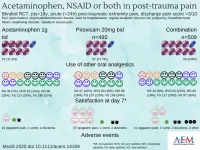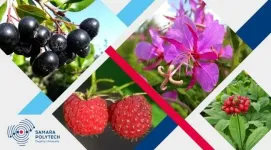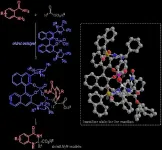How cells recycle the machinery that drives their motility?
2021-02-09
(Press-News.org) Research groups at University of Helsinki and Institut Jacques Monod, Paris, discovered a new molecular mechanism that promotes cell migration. The discovery sheds light on the mechanisms that drive uncontrolled movement of cancer cells, and also revises the 'text book view' of cell migration.
The ability of cells to move within our bodies is critical in wound healing, as well as for immune cells to patrol in our tissues to hunt bacterial and viral pathogens. On the flip-side, uncontrolled movement of cells is a hallmark of cancer invasion and metastasis.
The machinery that drives cell migration is a complex network of dynamic filaments composed of a protein actin. Actin exists in monomeric form, but like Lego bricks, different types of filamentous structures can be built from actin monomers in cells. Actin filaments are organized in cells in a way that their rapidly elongating plus-ends face the plasma membrane, whereas their minus-ends are oriented away from the plasma membrane. Elongation of actin filaments at their plus-ends against the plasma membrane generates the force to push the leading edge of cell forward during cell migration. To maintain a sufficient supply of monomeric actin subunits for filament elongation, actin filaments must be rapidly disassembled in cells, and this is believed to occur at their minus-ends. An important factor that limits actin filament disassembly to their minus-ends is Capping Protein, which binds very tightly to filament plus-ends to block filament elongation and shortening (see related figure).
A new study published in Nature Cell Biology reveals that this 'text book view' of cell migration needs to be revised. The research, led by Academy Professor Pekka Lappalainen from HiLIFE Institute of Biotechnology, University of Helsinki, revealed that a conserved actin-binding protein, Twinfilin, efficiently removes Capping Protein from the filament plus-ends ends. This leads to filament depolymerization also from their 'aged' plus-ends, which no longer push the leading edge of cell forward. In the absence of Twinfilin, actin filament recycling is diminished, filaments push the cell edge forward less efficiently, and cell migration is slower.
"Our results suggest that Twinfilin and Capping Protein make together a 'molecular clock', which ensures that the 'productive' actin filaments pushing the plasma membrane have a sufficient supply of actin monomers, whereas the 'aged' actin filaments that no longer push the plasma membrane are disassembled," says Lappalainen.
"This study highlights the need of several proteins with different functions to act in synergistic manner to maintain the normal morphology and functions of actin networks in cells," continues Dr. Markku Hakala who is the main author of this study.
Despite extensive studies, the precise mechanisms by which actin monomers are recycled in cells has remained elusive. The new study adds an important piece in this puzzle by reveling how Capping Protein is removed from actin filament plus-ends to enable their rapid disassembly. These findings also create a basis for further studies to understand how irregularities in actin disassembly machinery cause severe diseases and developmental disorders.
"Uncontrolled expression of Twinfilin is linked to many diseases, such as breast cancer invasion and lymphoma progression. Our work, therefore, also sheds light on the molecular mechanisms that drive uncontrolled movement of cancer cells," concludes Lappalainen.
INFORMATION:
[Attachments] See images for this press release:

ELSE PRESS RELEASES FROM THIS DATE:
2021-02-09
Glaciers are not only melting, but also collapsing in the Third Pole region. In 2016, two glaciers in the western Third Pole's Aru Mountains collapsed, one after another. The first collapse caused nine human casualties and the loss of hundreds of livestock. However, that may not be the end of the catastrophe.
According to a study recently published in The Cryosphere, meltwater from ice avalanches has been filling downstream lakes in a way that may cause previously separated lakes to merge within the next decade, thus disrupting the function of ecosystems in the region.
"The collapse of Aru glaciers has both short-term and long-term impacts on downstream lakes," said Dr. LEI Yanbin, lead author of the study and a researcher at the Institute of Tibetan Plateau Research ...
2021-02-09
Science always strives to replace complex natural objects and phenomena with simpler models. Scientists of Samara Center for Theoretical Materials Science (SCTMS) of Samara Polytech have developed methods to simplify the crystal structure of a substance to obtain chemically important knowledge. The main approaches are described in the article published in the Structural Chemistry journal IF 2.081 (doi:10.1007/s11224-020-01724-4).
"The main goal of simplifying any crystal structure is to understand the features of its structure and properties, and the simplification ...
2021-02-09
The BioRescue research project, a programme aiming at saving the northern white rhinoceros from extinction, exemplifies the challenges to overcome when conducting research and conservation in an international consortium in times of a global pandemic. COVID-19 hampered communication and travels, prevented or delayed crucial procedures, caused losses in revenues and by that may have lowered the chances of a survival of the northern white rhino. The consortium adjusted strategies, gained valuable knowledge during these challenging times and continued with its mission. The effects of the pandemic on the BioRescue project are described in detail in a scientific paper published in the Journal ...
2021-02-09
Adult progenitor cells are present in the Drosophila fly as early as its larvae stage. These cells are the only ones that are maintained throughout development and they are responsible for giving rise to adult tissues and organs. Headed by Jordi Casanova (also an IBMB-CSIC researcher), the Development and Morphogenesis in Drosophila lab at IRB Barcelona has identified the headcase (hdc) gene as responsible for the unique characteristics of these adult progenitor cells.
"In our study, mainly using the powerful genetic tools available in Drosophila, we were able to show that this gene regulates the development ...
2021-02-09
Scientists studying forest dwelling butterflies in Central and South America have discovered that changes in the way animals perceive and process information from their environment can support the emergence of new species. The study led by the University of Bristol, and published today [9 February] in the Proceedings of the National Academy of Sciences (PNAS), has implications for how new species might evolve and the underappreciated role of changes in the brain.
The international team, led by Dr Stephen Montgomery from the School of Biological Sciences at the University of Bristol, compared ...
2021-02-09
BOSTON -- Hospitals across the United States have gone to great lengths to implement infection control measures to prevent transmission of SARS-CoV-2. And yet, as the pandemic has unfolded, many health care settings have experienced clusters of cases, with the virus spreading among patients, staff or both. Some clusters have been easily traced back to break rooms and shared meals. But other clusters have been challenging to trace and contain. In September 2020, Brigham and Women's Hospital detected a cluster of infections that would ultimately include 14 patients and 38 staff members. The hospital rapidly activated its incident command structure in order to coordinate a controlled response to contain the cluster. Steps taken included widespread ...
2021-02-09
DES PLAINES, IL -- The combination of a high?dose NSAID with paracetamol does not increase the analgesic effect compared to paracetamol alone. Researchers also found that paracetamol alone is superior to high?dose NSAID alone for posttraumatic extremity pain. These are the findings of a study titled Acetaminophen, or nonsteroidal anti-inflammatory drugs, or combination of both analgesics in acute post-trauma pain: a randomized controlled trial, to be published in the February 2021 issue of Academic Emergency Medicine (AEM), a journal of the Society for Academic Emergency Medicine (SAEM).
According to the study, taking into account its superior efficacy ...
2021-02-09
Today, the average American is unlikely to spend time worrying about malaria. Although the disease is commonly perceived to be restricted to other parts of the world, it played a significant role in shaping American history. It even helped turn the tide of the American Revolutionary War by infecting so many British soldiers that General Cornwallis was forced to surrender at Yorktown.
First-year students in a 2019 introductory seminar class led by Erin Mordecai, an assistant professor of biology in the School of Humanities and Sciences (H&S), delved ...
2021-02-09
Samara Polytech chemists investigated the potential anticarcinogenic effects of extracts obtained from plant materials of lingonberry, raspberry, black chokeberry, grapes, Krasnodar green tea, ginseng, fireweed and coffee, and also evaluated their effect on the growth and viability of colon cancer cells. The research was carried out within the framework of the state assignment for fundamental research No. 0778-2020-0005, its results were published Dec. 29, 2020 in the journal Proceedings of Universities. Applied Chemistry and Biotechnology (DOI: https://doi.org/10.21285/2227-2925-2020-10-4-613-626).
Prevention is the most cost-effective and long-term strategy for controlling this disease. It is now well known ...
2021-02-09
A lot of our medicines and other bioactive drugs are based on chemical structures called "enantiomers"-- molecules that are mirror images of each other and are non-superimposable. Notable among them are chiral N,N-acetals contained in diuretic drugs like bendroflumethiazide and thiabutazide, used to treat high blood pressure and edema. Because an enantiomer and its mirror image version often have different biological activities, with only one of them having pharmacological utility, an "enantioselective" or asymmetric synthesis yielding the desired enantiomer in greater amounts is highly desirable.
In the case of N,N-acetals, several studies have demonstrated their enantioselective preparation from aldehydes, aldimines, or enamines. However, in all these cases, ...
LAST 30 PRESS RELEASES:
[Press-News.org] How cells recycle the machinery that drives their motility?








